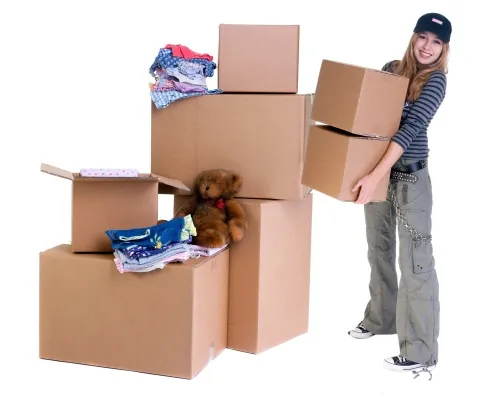Most homebuyers are so excited to move into their new home that they don't even mind that their coffee table was scratched or their favorite dinner plates were chipped during the move.

But there is no reason for your household items to get battered during the jump to your new dream home. By following these packing savings tips and tricks, your delicate items will be damage-free when they arrive at your new home.
The first step is to stock up on packing supplies that will make your next move easier:
- Sturdy, corrugated cartons and boxes from moving companies or truck rental companies are good-quality packing materials that will help to prevent damage to your items. Boxes disposed by your local grocery or supermarket can also be used in packing, but keep in mind that insect eggs and insects can live in food boxes.
- Use markers and labels to mark the designated room and box number as well as the contents of the box, and be sure to include whether the items are "fragile." It is also a good idea to grab a notebook and pencil and create a log to identify and track the total number of boxes and cartons packed per room.
- Gummed tape or packing tape that is 1 1/2 to 2 inches wide is stronger than masking tape and will hold the weight of the contents.
- Tissue and craft paper come in handy when packing up delicate items, while foam peanuts and Styrofoam pellets work well to fill the contents of the box. Utilizing old newspapers will save you money, but remember that ink may rub off and stain your clothing or other items. Blankets, clothing, crumpled paper and pillows are also good "fillers" that can help to avoid breakables.
- Have scissors and/or a sharp knife on-hand when it comes time to pack and unpack your items.
Once you have gathered all the necessary packing materials, the next step is constructing a packing plan. Packing a couple of cartons a day six to eight weeks before the move date will make it less stressful and easier when it comes time to move. Try to focus on packing one room at a time and consider throwing out items you don't use. A good rule of thumb to follow: if you haven't used it in the past 12 months, toss it! It is also recommended to keep the weight of your boxes under 50 pounds. For example, heaver items such as books should be packed in smaller boxes to make them easier to carry.

Make sure you are also using the best packing techniques and materials for each of your belongings:
- Dishes - Plates, saucers and other dishware can be stacked and wrapped three or four pieces at a time and placed on edge, not flat, in the bottom of medium-sized boxes lined with crumpled packing paper. Delicate cups and glasses should be filled with crumpled tissue or packing paper and wrapped individually. Place these delicate items near the top of the box with crumpled packing paper between each layer to ensure there are no gaps.
- Lamps - Place shades individually in boxes with plenty of packing paper, not newspaper. Wrap cords around bases and secure these items in dresser drawers surrounded by clothing or in large boxes stuffed with packing paper.
- Electronics - For valuable electronic equipment, place items in original cartons if available. Otherwise pack these items upright in strong, corrugated cartons surrounded by old blankets or protective padding. Detachable cords should be wrapped individually and placed in labeled plastic bags for easy identification.
- Clothes - Anything hanging in closets such as suits, coats and dresses fit well in reusable boxes that can be stored according to the season. Other clothing can remain folded in dresser drawers.
- Dressers - Load drawers with small breakables and surround with clothing or blankets, and secure drawers with padding or tape. Do not overload drawers with heavy items.
- Mirrors - Wrap small paintings, mirrors, and pictures with paper and place on edge in boxes. For larger mirrors and paintings, wrap with cardboard and stand on their sides in corrugated cartons.
- Tools - Drain gas and oil from any power equipment before moving. Pack smaller tools like wrenches and hammers in boxes. Rakes, shovels and other long-handled tools should be wrapped together with tape.
- Flammables - Do not pack flammable liquids or combustibles. These items can possibly leak during shipment and may cause damage to your items or others.
After your household items are packed, take a few steps to ensure your new home is clean before you start to move:
- Makes sure to clean all rooms before hauling in your furniture and boxes. Dust baseboards, clean and vacuum all carpets and floors, and clear out storage spaces.
- Air out your new home by opening all windows. If it's cold outside, crack windows long enough to clear the air.
- Put down old blankets and sheets so that your helpers are not tracking in dirt during the move.
Taking the extra time and care to pack each of your items securely will make the unpacking process easier. Packing can often be a stressful and time-consuming task, but with a little patience and motivation, you will be settled into your new dream home and ready to relax in no time.
Here are some related articles:
Save this article to:
back to top